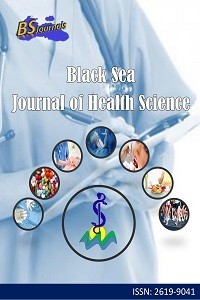Serebral Palsili Hastalarda Perkütan Endoskopik Gastrostomi Sırasında Uygulanan Prosedüral Sedasyon Uygulamaları
Serebral palsi, Sedasyon, Anestezi, Malnutrisyon, Perkütan endoskopik gastrostomi
Procedural Sedation Practices during Percutaneous Endoscopic Gastrostomy in Patients with Cerebral Palsy
Cerebral palsy, Procedural sedation, Anesthesia, Malnutrition, Percutaneous endoscopic gastrostomy,
___
- Ateş O, Kart Y, Hakgüder G, Mustafa Olguner M, Nur Aslan N, Yeşim Öztürk Y, Feza M. Akgür FM. 2006. Percutaneous endoscopic gastrostomy: Our experiences. Çocuk Cer Derg, 20(3): 170-173.
- Aytuluk HG. 2020. Evaluation of advanced behavior guidance techniques used in dentistry: sedation and general anesthesia. Osmangazi Tıp Derg, 42(5): 466-473.
- Azar AR, Rahnemaiazar AA, Naghshizadian R, Kurtz A, Farkas DT. 2014. Percutaneous endoscopic gastrostomy: Indications, technique, complications and manageent. World J Gastroenterol, 20(24): 7739-7751.
- Bawazir UA. 2020. Percutaneous endoscopic gastrostomy in children less than 10 kilograms: A comparative study. Saudi J Gastroenterol, 26(2): 105-110.
- Butler MG, Hayes BG, Hathaway MM, Begleiter ML. 2000. Specific genetic diseases at risk for sedation/anesthesia complications. Anesth Analg, 91: 837-55.
- Chong SK. 2001. Gastrointestinal problems in the handicapped child. Curr Opin Pediatr, 13(5): 441-446.
- Chung HK, Lightdale JR. 2016. Sedation and monitoring in the pediatric patient during gastrointestinal endoscopy. Gastrointest Endosc Clin N Am, 26: 507–525.
- Cudny ME, Wang NE, Bardas SL. 2013. Adverse events associated with procedural sedation in pediatric patients in the emergency department. Hosp Pharm, 48: 134-142.
- Durakbaşa ÇU, Okur H, Mutuş HM, Baş A, Sert M, Tosyalı AN. 2008. Çocuklarda perkütan endoskopik gastrostomi (PEG) uygulamalarının endikasyonları, komplikasyonları ve sonuçlarına ilişkin bir derleme Çocuk Cer Dergi, 22(3): 122-126.
- Enever GR, Nunn JH, Sheehan JK. 2000. A comparison of post-operative morbidity following outpatient dental care under general anaesthesia in paediatric patients with and without disabilities. Int J Paediatr Dent, 10(2): 120-125.
- Erkin G, Kacar S, Özel S. 2005. Serebral palsili hastalarda gastrointestinal sistem ve beslenme problemleri. Turk J Phys Med Rehab, 51(4): 150-155.
- Gamlı M, Pala Y, Selçuk A, Özcan M, Horasanlı E. 2005. İleri derecede kifoskolyozlu femur kırığı olgusunda unilateral spinal anestezi. Gazi Tıp Derg, 16: 37-41.
- Gross WL. 2015. Non-operating room anaesthesia. In: Miller RD, editor. Miller's Anaesthesia. 8th ed. Elsevier, Philadelphia, US, pp. 3112.
- Hausman LM, Reich DL. 2008. Providing safe sedation/analgesia: An anesthesiologist’s perspective. Gastrointest Endosc Clin N Am, 18: 707-716.
- Kuperminc MN, Stevenson RD. 2008. Growth and nutrition disorders in children with cerebral palsy. Dev Disabil Res Rev, 14: 137-146.
- Kurihara M, Kumagai K, Nakae Y, Kurihara K. 2001. Latex allergy in patients with severe motor and intellectual disabilities syndrome. No To Hattatsu, 33: 241-245.
- Lightdale JR, Mahoney LB, Schwarz SM, Liacouras CA. 2007. Methods of sedation in pediatric endoscopy: a survey of NASPGHAN members. J Pediatr Gastroenterol Nutr, 45: 500-502.
- Maeda S, Tomoyasu Y, Higuchi H, Ishii-Maruhama M, Egusa M, Miyawaki T. 2015. Independent predictors of delay in emergence from general anesthesia. Anesth Prog, 62: 8–13.
- Maranhao MV. 2005. Anesthesia and cerebral palsy. Rev Bras Anestesiol, 55: 680-702.
- Mason KP, Seth N. 2019. The pearls of pediatric sedation: polish the old and embrace the new. Minerva Anestesiol, 85: 1105-1117.
- McSweeney ME, Kerr J, Jiang H, Lightdale JR. 2015. Risk factors for complications in infants and children with percutaneous endoscopic gastrostomy tubes. J Pediatr, 166: 1514-1519.
- Nolan J, Chalkiadis GA, Low J, Olesch CA, Brown TC. 2000. Anesthesia and pain management in cerebral palsy. Anesthesia, 55: 32-41.
- Nugud A, Alhoot S, Agabna M, Babiker MOE, El Bashir H. 2021. Analgesia and sedation modalities used with botulinum toxin injections in children with cerebral palsy: a literature review. Sudan J Paediatr, 21(1): 6-12.
- Ouchi K, Sugiyama K. 2015. Required propofol dose for anesthesia and time to emerge are affected by the use of antiepileptics: prospective cohort study. BMC Anesthesiol, 15: 34.
- Sankar C, Mundkur N. 2005. Cerebral palsydefinition, classification, etiology and early diagnosis. Indian J Pediatr, 72: 865-868.
- Serdaroğlu A, Cansu A, Ozkan S, Tezcan S. 2006. Prevalence of cerebral palsy in Turkish children between the ages of 2 and 16 years. Dev Med Child Neurol, 48: 413–416.
- Sipes M, Matson JL, Belva B, Turygin N, Kozlowski AM, Horovitz M. 2011. The relationship among side effects associated with anti-epileptic medications in those with intellectual disability. Res Dev Disabil, 32(5): 1646-1651.
- Sit M, Kahramansoy N, Tekelioglu UY, Ocak T. 2013. Our experience in percutaneous endoscopic gastrostomy. JAREM, 3: 66-68.
- Souter KJ, Davies JM. 2012. Diversification and specialization in anesthesia outside the operating room. Curr Opin Anaesthesiol, 25: 450-452.
- Wang YC, Lin IH, Huang CH, Fan SZ. 2012. Dental anesthesia for patients with special needs. Acta Anaesthesiol Taiwan, 50: 122-125.
- Wongprasartsuk P, Stevens J. 2002. Cerebral palsy and anesthesia. Paediatr Anaesth, 12: 296-303.
- Yılbaş AA, Ayhan B, Akıncı SB, Sarıcaoğlu F, Aypar Ü. 2013. The effect of different end-tidal desflurane concentrations on bispectral ındex values in normal children and children with cerebral palsy. Turk J Anaesth Reanim, 41: 200-205.
- Yayın Aralığı: Yılda 4 Sayı
- Başlangıç: 2018
- Yayıncı: Cem TIRINK
Antalya İlinin Tularemi Açısından Değerlendirilmesi
Serpil MIZRAKÇI, Emine Kübra DİNDAR DEMİRAY
Yaşlılıkta Kırılganlık ve Üriner Sistem Enfeksiyonları
Emine Kübra DİNDAR DEMİRAY, Sevil ALKAN, Taylan ÖNDER, Hatice ÖNTÜRK, Ayşe ÖNDER
Melda Pelin AKKİTAP, Birsay GÜMRÜ, Ömer Birkan AĞRALI, Selin BABALI
Nutrition Consumption Frequencies Scale of Change: Validity and Reliability Study
Burhan BAŞARAN, Hilal PEKMEZCİ PURUT
Nozokomiyal Rotavirüs Enfeksiyonları
Sevil ALKAN, Emine Kübra DİNDAR DEMİRAY, Anıl AKÇA, Taylan ÖNDER, Servan VURUCU
Manyetik Rezonans Görüntüleme ve Diş Hekimliği
Gözde EŞER, Şuayip Burak DUMAN, Melike BAŞARAN, Firdevs AŞANTOĞROL
Tuğba AYDIN YILDIRIM, Nurcan GEBEŞOĞLU
Adolesanlarda Cilt Sorunlarinin Beslenme Alişkanliği ve Duygu Kontrolü İle İlişkisi
Aliye ÖZENOĞLU, Gülay KURT, Elif REİS, Kamil ALAKUS
Stress Urinary Incontinence during Pregnancy in Primigravidae and Their Quality of Life
Nermin KILIÇARSLAN, Hande GÜRBÜZ, Ayşe Neslihan BALKAYA, Derya KARASU, Kaan DEMİRÖREN, Mehmet GAMLI
